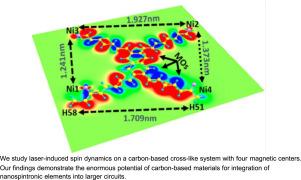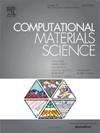Ab initio study of the laser-induced ultrafast spin dynamics on Ni4@C40H34 carbon cross
IF 3.1
3区 材料科学
Q2 MATERIALS SCIENCE, MULTIDISCIPLINARY
引用次数: 0
Abstract
Miniaturizing magnetic logic is a significant challenge in spintronics. Magnetic molecules, with their complex properties, play a central role in this area. They offer encouraging prospects for today’s and future nanoscale magnetic applications. Here, we suggest a carbon cross system for spin-based logic operability with emphasis on laser-induced spin manipulation across carbon nodes. Using the spin density of the nickels, we accomplish six spin-transfer as well as several local-spin flip processes. All the spin dynamics scenarios can be accomplished in the subpicosecond regime. Varying the strength of the magnetic field can considerably alter the local spin-flip scenarios, while leaving the global spin-transfer processes mostly unchanged. Building all-spin-based functionality can be done with increased speed due to the controllable spin-transfer and spin-flip-transfer scenarios. Furthermore, reversible logic operability leads to reduced power consumption. Here, the reversed spin-transfer processes can be accomplished both with different and the same laser pulses. The impact of the angles of incidence of the laser pulse on the spin dynamics processes is examined. The whole spin dynamics is realized within the subpicosecond domain. The findings of our study offer important knowledge and new understanding on how to successfully control spin dynamics processes on microscopic molecular systems in order to attain a particular logic operation.

Ni4@C40H34碳交叉上激光诱导超快自旋动力学的从头算研究
磁逻辑小型化是自旋电子学的一个重大挑战。具有复杂性质的磁性分子在这一领域发挥着核心作用。它们为今天和未来的纳米级磁性应用提供了令人鼓舞的前景。在这里,我们提出了一个碳交叉系统,用于基于自旋的逻辑可操作性,重点是激光诱导的自旋操纵跨碳节点。利用镍的自旋密度,我们完成了六个自旋转移和几个局部自旋翻转过程。所有的自旋动力学场景都可以在亚皮秒范围内完成。改变磁场强度可以显著改变局部自旋翻转场景,而保持全局自旋转移过程基本不变。由于可控的自旋转移和自旋翻转转移场景,构建基于全自旋的功能可以以更快的速度完成。此外,可逆的逻辑可操作性降低了功耗。在这里,不同的激光脉冲和相同的激光脉冲都可以实现反向自旋转移过程。研究了激光脉冲入射角对自旋动力学过程的影响。整个自旋动力学在亚皮秒范围内实现。我们的研究结果为如何成功地控制微观分子系统的自旋动力学过程以达到特定的逻辑运算提供了重要的知识和新的理解。
本文章由计算机程序翻译,如有差异,请以英文原文为准。
求助全文
约1分钟内获得全文
求助全文
来源期刊

Computational Materials Science
工程技术-材料科学:综合
CiteScore
6.50
自引率
6.10%
发文量
665
审稿时长
26 days
期刊介绍:
The goal of Computational Materials Science is to report on results that provide new or unique insights into, or significantly expand our understanding of, the properties of materials or phenomena associated with their design, synthesis, processing, characterization, and utilization. To be relevant to the journal, the results should be applied or applicable to specific material systems that are discussed within the submission.
 求助内容:
求助内容: 应助结果提醒方式:
应助结果提醒方式:


